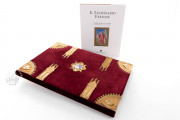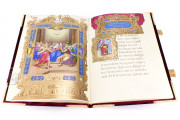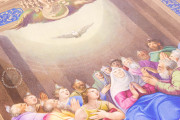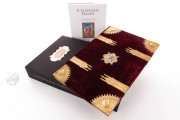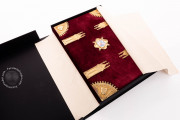The majestic liturgical manuscript known as the Lezionario Farnese is one of the most elegant illuminated manuscripts from the Renaissance. Also known as Towneley Lectionary due to its subsequent owners, it was produced in Rome shortly after the mid-sixteenth century. Featuring six full-page miniatures and several gilded framing devices, the codex represents the apex of the art of illumination.
Fresco-like Miniatures of the Farnese Lectionary
The Lezionario Farnese, taking its name after his commissioner Alessandro Farnese, is a work of monumental proportions and wealth of embellishments. For hundreds of years, the codex served as one of the missals used by popes and princes of the Church during the solemnities held at the Sistine Chapel.
The iconographic apparatus echoes the frescoes of Michelangelo and Raphael due to the skillful use of colors by the artist. Particularly evocative is the use of different types of gold, which confer the manuscript beautifully gleaming glares. The gilded frames are adorned with putti, masks, floral motifs, and allegorical figures in grisaille.
Cardinal and Connoisseur of the Arts
Alessandro Farnese, also known as Cardinal Farnese (1520-1589) appointed by his grandfather Pope Paul III, was the commissioner of this sumptuous work. Cardinal Farnese was known for his love for and knowledge of the arts so it comes as no surprise that he acted as patron of many artists, such as Giulio Clovio (1498-1578).
In the 1540s, Clovio entered the service of Cardinal Alessandro Farnese and he served him for the rest of his life. Born in Croatia in 1516, he was the most praised illuminator of his time, so much so that Giorgio Vasari, in the second edition of his Lives of the Artists, refers to him as "Michelangelo in little."
Littera Antiqua Rotunda
The Townseley Lectionary exhibits a beautiful example of littera antiqua rotunda, a slightly different version of the humanistic script, elaborated in the early fifteenth century. Six different scribes were identified and it is believed that two of them could be Giovan Francesco Cresci and Marc'Antonio Rossi.
Unfortunately, the original binding went missing with the arrival of Napoleon's troops in Italy. The current one is a copy of a later binding from 1809-1810 when the codex was re-bound in a red velvet Neo-Gothic cover of significant beauty and refinement (by the hands of Benjamin II and James Smith). The binding features gilded silver ferrules and clasps and, on the front cover, the polychrome porcelain coats of arms of the Towneley family.
We have 2 facsimiles of the manuscript "Farnese Lectionary":
- Lezionario Farnese (Vermeil Binding) facsimile edition published by Franco Cosimo Panini Editore, 2008
- Lezionario Farnese (Silver Binding) facsimile edition published by Franco Cosimo Panini Editore, 2008


